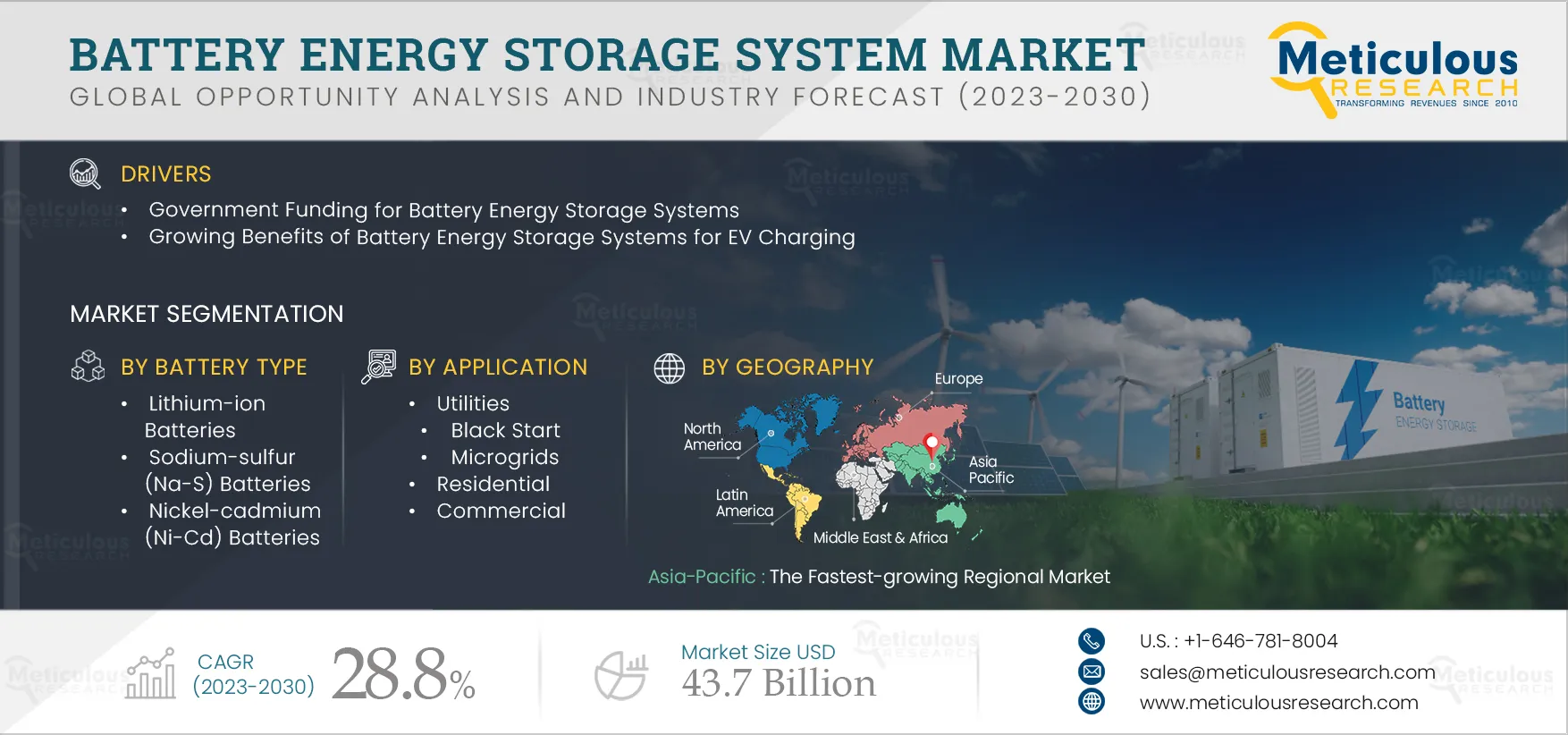The Battery Energy Storage System Market is projected to reach $43.7 billion by 2030, at a CAGR of 28.8% during the forecast period 2023–2030. The growth of the battery energy storage systems market is driven by government funding for battery energy storage systems and the growing benefits of battery energy storage systems for EV charging. Moreover, the growing demand for battery energy storage systems for commercial applications and the decline in the prices of lithium-ion batteries provide significant opportunities for the key players in the global battery energy storage systems market.
However, the high capital required for installing battery energy storage systems restrains the market’s growth to some extent. Additionally, the lack of standardization in storage systems and overheating of lithium-ion batteries poses challenges to the growth of the battery energy storage systems market. Furthermore, advanced lithium-ion batteries and energy storage as a service are the key trends observed in the battery energy storage systems market.
Here are the top 10 companies operating in the Battery Energy Storage System Market
General Electric Company (U.S.)
Founded in 1889 and headquartered in Boston, Massachusetts, U.S., General Electric Company is a leading provider of battery energy storage systems & services. The company provides battery energy storage solution that offers new application flexibility and unlocks new business value across the energy value chain, from conventional power generation, transmission & distribution, and renewable power, to industrial and commercial sectors. The battery energy storage solution supports diverse applications, including firming renewable production, stabilizing the electrical grid, controlling energy flow, and optimizing asset operation.
GE’s Reservoir Solution is a flexible, compact energy storage solution for AC or DC-coupled systems. It combines GE’s advanced technologies and expertise in plant controls, power electronics, battery management systems and electrical balance of the plant – all backed by GE’s performance guarantees. The company operates through four business segments, namely, Aerospace, Renewable Energy, Power, and HealthCare.
Siemens AG (Germany)
Founded in 1847 and headquartered in Munich, Germany, Siemens AG is a global provider of battery energy storage systems. The company’s SIESTORAGE NEO solution allows high power charging on weak grid connections, storing self-generated energy, balancing peak loads, smart and efficient load management, and power factor correction. Further, the company offers maintenance services and remote operation support for battery energy storage systems.
Siemens Energy BlueVault Storage solutions promote on-demand, dispatchable renewable power, increase profitability during fluctuating demand, optimize on-site power sources, capitalize on peak loads (while reducing demand charges), increase conventional power plant flexibility, and provide operating reserves while improving the security of energy supply. Further, the company provides BlueVault energy storage solutions, an advanced lithium-ion battery-based solution for all-electric and hybrid energy-storage applications. BlueVault is designed to help ensure power continuity and minimize emissions, with an end goal of a low-emission platform. The company operates through three business segments, namely Digital Industries, Smart Infrastructure, and Other revenue.
ABB Ltd. (Switzerland)
Founded in 1988 and headquartered in Zürich, Switzerland, ABB is a pioneering technology leader that works closely with utility, industry, transportation, and infrastructure customers. The company operates mainly in robotics, power, heavy electrical equipment, and automation technology. The company provides battery energy storage systems for sectors such as e-mobility, renewables, commercial & industrial, and distribution utility. It offers an energy storage solution controller, eStorage OS, developed for integration with behind-the-meter loads and generation assets.
ABB’s fully digitalized energy storage portfolio raises the efficiency of the grid at every level with factory-built, pre-tested solutions that achieve extensive quality control for the highest level of safety. ABB’s solutions can be deployed to the customer site, leading to faster installation, shorter project execution time, and higher customer savings. The company operates through four business segments, namely, Electrification, Motion, Process Automation, and Robotics & Discrete Automation.
Panasonic Life Solutions India Pvt. Ltd. (India) (A Part of Panasonic Holdings Corporation)
Established in 2006 and headquartered in Haryana, India, Panasonic Life Solutions is India’s regional hub, driving growth and building deeper inroads into the fast-emerging Asiatic, Middle Eastern and Western economies. Panasonic Holdings Corporation operates through five business segments, namely, Lifestyle, Industry, Automotive, Connect, and Energy. Through the Industry segment, the company offers relays, switches, power supplies, touch panels, motors, sensors, laser markers, capacitors, inductors, resistors, circuit board materials, semiconductor device materials, molding compounds, and LCD panels.
Honeywell International Inc. (U.S.)
Incorporated in 1985 and headquartered in North Carolina, U.S., Honeywell International is a leading provider of battery energy storage systems. The company provides an easy to customize, scale, manufacture, install, configure, maintain and recycle battery energy storage systems, including Battery Modules, Battery Management Systems (BMS), Energy Management Systems (EMS), and BESS subsystems such as HVAC and security. The company offers Battery Energy Storage System (BESS) Platform, which integrates Honeywell asset monitoring, distributed energy resource management, supervisory control and analytics functionality to enable organizations to accurately forecast and optimize their overall energy use. The company provides battery energy storage systems (BESS) that help commercial and industrial customers, independent power producers, and utilities improve grid stability.
Founded in 1971 and headquartered in Taipei, Taiwan, Delta Electronics is a Taiwanese electronics manufacturing company and a global provider of power and thermal management solutions. Delta offers some of the most energy-efficient power products in the industry, including switching power supplies with an efficiency of over 90%, telecom power with up to 98%, and PV inverters with up to 99.2% efficiency. The company also developed the world‘s first server power supply certified as 80 Plus Titanium. The company provides a wide range of solutions, including industrial automation solutions, building automation solutions, data center solutions, telecom energy solutions, smart energy solutions, display and monitoring solutions, and EV charging solutions. The company operates through four business segments, namely, Power Electronics, Automation, Infrastructure, and Others.
























